-
September 20, 2016 by Total Fire and Safety
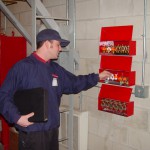
Since they don’t wear a cape or colorful tights, to the untrained eye the fire alarm technician is just the guy who comes in to check the safety of your fire equipment. But in reality, the fire alarm technicians at Total Fire & Safety are specialized employees who actually end up saving lives by making sure your equipment functions properly in an emergency situation at your commercial building!
Yet these humble heroes walking among us in a simple Total Fire & Safety uniforms often go unappreciated because people don’t understand the special powers they possess and bring into play on a daily basis. For example, all Total Fire & Safety fire alarm technicians…
1. Battle the forces of evil at a moment’s notice! When the call comes, the fire alarm technicians jump in their “Total Firemobile” and rush bravely in to battle the villain, whether it’s a malfunctioning backflow problem or a damaged sprinkler system. They soundly thwart the forces of equipment failure by repairing and replacing the critical systems, always emerging victorious. While Chicagoland sleeps, the Total Fire & Safety technician is on the job, throughout greater Chicagoland, lndiana and lower Wisconsin. 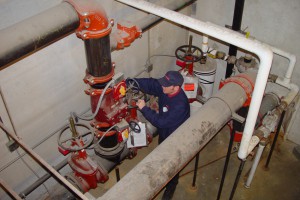
2. Excel at searching out the right clues to every puzzle. The crafty fire alarm technician can decode the secret language and uncover the valuable clues in blueprints, diagrams, specifications, schematics and operational/product manuals to find the information that saves the day and restores equipment to its proper functionality. It’s all in a day’s work for the fire alarm technician!
3. Protect their customers and save the day. The Total Fire & Safety fire alarm technician deals directly with our customers, listening to their needs and providing the best, safest solutions for their situation. With professionalism and skill, they communicate with headquarters to make sure all is well for their customer, humbly accepting a mere humble thanks for their efforts.
4. Go wherever the wind takes them…even overnight. The life of a fire alarm technician is filled with adventure on the road, going where they are called and serving willingly. Total Fire & Safety fire alarm technicians are flexible enough to travel overnight in order to perform inspections and repairs for clients that are not so close by. That’s what all heroes do!
Bravery, trustworthiness and competence are all marks of the highly trained fire alarm technicans at Total Fire & Safety. Do you have what it takes? We are always looking for skilled individuals to join our force of heroes. Those who qualify can apply at apply at Total Fire & Safety for a distinguished career as well as competitive compensation and benefits such as health and dental and a position in a growing company with room for advancement. Contact Total Fire & Safety today about opportunities and learn how being an everyday hero with us can lead to exciting opportunities to do good in the world!
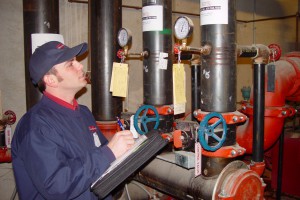
Category: Fire Alarm Monitoring, Fire Extinguishers, Fire Safety, Sprinkler Systems, Suppression system, Total Fire and Safety Tags: fire alarm, fire alarm for business, fire alarm tech jobs, fire alarm technician, fire alarm technician jobs, fire safety, fire safety careers, fire safety jobs, technician jobs, Total Fire & Safety, total fire & safety jobs, Total Fire and Safety, total fire and safety jobs | Comments Off on The Fire Alarm Technician: Not All Superheroes Wear Capes!
-
June 9, 2016 by Total Fire and Safety
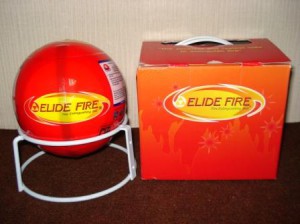 www.elidefire.com Elide Fire has a zany idea that might change the way that we fight fires in the future. These ball-shape extinguishers are like hand-held bombs that disperse the same chemicals that are found in normal fire extinguishers. To activate, you simply toss one toward the fire, and these little firefighters take care of everything. They are designed to activate within three seconds of being in contact with fire. They also work as alarms, emitting a loud sound when activated.
You may be thinking, could these really work to replace fire extinguishers as we know them? Although having red balls filled with chemicals sitting in your kitchen or near electrical plugs may clash with your color scheme, they would be able to activate even when you’re not at home. This feature could potentially save lives as well as property damage (as long as they never accidentally activate without fire, though. That would be a mess!).
The best part about this invention, however, is that it would be extremely easy to operate compared to a normal extinguisher. Using these extinguisher balls would be as simple as, well, tossing a ball. Even a child could do it (in a desperate situation, of course). Who knows, perhaps the fire training industry will soon have to create a simplified program that will more closely resemble pitching practice than fire safety training.
The Extinguisher Ball has a lifespan of five years, and is meant to be mounted or displayed in fire-prone places. Total Fire and Safety is keeping an eye on this new product for further developments, but in the meantime, those basic red fire extinguishers hanging on your wall are your best bet in the event of an actual fire. For more information on fire extinguishers and wireless fire alarms currently available, contact Total Fire & Safety at 630-960-5060.
Category: Fire Extinguishers, Fire Extinguishers, Fire News, Fire Safety, Total Fire and Safety, Trends Tags: alternative fire extinguisher, elide extinguisher balls, elide extinguishers, elide fire, Fire Extinguisher, fire extinguisher balls, fire extinguisher technology, fire fighting technology, fire news, fire rextinguisher bombs, fire safety news | Comments Off on Fire News: An Exploding Fire (Extinguisher?) Ball?
-
April 13, 2016 by Total Fire and Safety
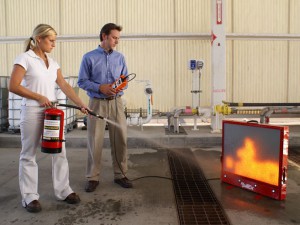
If your business has more than ten employees, they are going to need annual fire safety training. Some businesses rush to the least expensive program that will satisfy OSHA requirements, assuming that all training is the same; however, that’s simply not true. Fire safety training can vary in quality based on a number of factors, and many come with “hidden” fees that you may not be aware of. So what should you look for? Here are some important questions to ask before you book the training company.
1. What kind of course would you recommend? The course you need for your company should address the most probable emergencies that can occur at your facility. A training company worth its salt will tailor the course to your needs, surveying your business ahead of time to determine the most important content needed for your employees.
2. Who is teaching the course? Make sure the instructors are experienced professionals who know what real emergencies are like and how they occur. It’s even better if the instructor has experience with real-life emergencies. Nothing compares to the knowledge of a first responder who has faced countless fires and hazardous events. They can share personal stories, anecdotes and examples related to the training, which can make the class more interesting.
3. What will the course cover? Basic training courses cover how to use the fire extinguisher, but the most important thing employees should learn is WHEN to use the fire extinguisher. A good training course will focus on the importance of making fast and accurate, life-or-death decisions. Not only should your employees know how to fight fires, but also WHEN to fight the fire, and most importantly, when not to fight the fire. Evacuating and leaving it to the professionals is sometimes the best decision an employee can make.
4. Where will the training take place? Many fire safety trainings are performed outdoors, with a live burn in a pan that employees practice extinguishing. Although exciting, putting out a pan fire in a parking lot does not accurately simulate a realistic fire or emergency situation! Also, elements of the weather such as wind can affect the fire and unrealistically hamper the efforts of the employee trying to learn proper extinguishing techniques. It is much more effective to practice emergency procedures where they actually occur—inside the facility. With the help of digital technology, your employees can learn to extinguish the exact type of fire they would most likely face right at their worksite. This “on-the-spot” training also helps employees develop realistic evacuation plans and teach them to work as a team in an emergency situation.
5. Will there be extra costs involved with the equipment or the course materials? If the trainer is using “live burns”, or actual fires to practice extinguishing, you will need to have a burn permit and may incur any associated costs with setting up an outdoor space needed for the demonstration. If the training company uses your fire equipment for a live burn session, you will have to recharge them. You may not have budgeted for this unexpected, volatile cost, and it will vary based on how many turns each participant receives to extinguish the fire. The fire safety courses offered by Total Fire & Safety use high-tech, virtual simulators to practice extinguishing fires, which are versatile and allow more practice for each participant. These simulators feature virtual fire on a screen that responds realistically to the participant’s motions with the fire extinguisher. The indoor training gives each person multiple attempts with a full extinguisher every time until they feel confident with their firefighting skill. Compared to outdoor training, simulated training is more cost effective, accurate, completely green, and requires no messy clean-up or permit fees.
So before booking a company to perform fire safety training for your employees, ask these questions to make sure you receive your money’s worth for your employees and your business. No one can predict how an emergency will unfold, but the right training company can make sure your employees are not only prepared to fight a fire, but are adept at making quick decisions about whether or not it is safe to do so. For more information, contact the professionals at Total Fire & Safety at 630-960-5060.
Category: Fire Extinguishers, Fire Extinguishers, Fire Safety, Total Fire and Safety Tags: employee training, Fire Extinguisher, fire safety, fire safety training, fire training, fire training technology | Comments Off on Five Important Questions to Get Your Money’s Worth from Fire Safety Training
-
February 26, 2016 by Total Fire and Safety
 You may think you know the importance of first aid and fire safety, but the real impact of first aid and fire equipment training in the workplace is often overlooked. Whether your business is a high or low-risk environment, there are always risks that can lead to medical emergencies. You may think you know the importance of first aid and fire safety, but the real impact of first aid and fire equipment training in the workplace is often overlooked. Whether your business is a high or low-risk environment, there are always risks that can lead to medical emergencies.
1. Increasing profitability. A safer workplace means less missed workdays due to injuries. According to the National Safety Council, in 2012, nearly 5 million workers were injured at work, which costed employers a total of $198.2 billion.
2. Saving your employees time and money. It is proven that businesses and employees will save money if accidents are handled quickly and effectively. The National Safety Council attests that 25 percent of all emergency room visits can be avoided with basic first aid and CPR certification.
3. It really does save lives. If your employees don’t know how to handle injuries, the condition of the victim could worsen before the ambulance arrives, and cause further trauma and debilitation, not to mention medical costs and possibly, even death. Having a commercial first aid kit on the job sends a message to your employees that you value their health and well-being and are doing all you can to mitigate any injuries that occur on the job. It also shows that you never want your employees to be vulnerable to unattended injury.
4. It is required by law for many workplaces. The Occupational Safety and Health Administration requires businesses to provide first aid and CPR training to employees if there is no nearby clinic or hospital. Make sure you also have a commercial first aid kit available in your workplace. Obviously, if your business deals with risky materials or conditions, having a commercial first aid kit makes sense whether or not you are bound by law.
5. Teach your employees how to use emergency equipment. You spend money keeping your workplace up to code with commercial fire extinguishers and first aid kits, but these things don’t handle emergencies by themselves! Your employees need to know how to work fire extinguishers and use first aid supplies correctly. The investment need not be costly; a simple on-site class with the staff in attendance should suffice.
Total Fire & Safety can handle all your needs whether it be fire extinguishers, first aid kits, fire extinguisher training, or first aid training. For more information, visit our website or you can contact us at 630-960-5060.
Category: Fire Extinguishers, Fire Safety, First Aid Kits, Total Fire and Safety Tags: fire safety training, fire training, first aid, first aid kit, first aid training, training | Comments Off on Five Reasons Why Employees Should Have First Aid Training
-
February 9, 2016 by Total Fire and Safety
 It’s the time of year when temperatures drop and things get icy, but don’t be fooled. Fires still pose a very serious threat even in winter! Even though it’s been a milder winter than normal here in the Chicago area, it’s still important to make sure your water-based commercial sprinkler system is bullet-proof from the elements and always ready. In the Midwest, where subzero temperatures can hit at any time, it makes sense to be prepared. It’s the time of year when temperatures drop and things get icy, but don’t be fooled. Fires still pose a very serious threat even in winter! Even though it’s been a milder winter than normal here in the Chicago area, it’s still important to make sure your water-based commercial sprinkler system is bullet-proof from the elements and always ready. In the Midwest, where subzero temperatures can hit at any time, it makes sense to be prepared.
A commercial fire protection company can provide winter fire protection, but building owners need to do their part too! So how do you know you’re prepared? If you can answer these five questions affirmatively.
Are your water-based sprinkler system pipes insulated? Even indoors, if the weather gets cold enough, your sprinkler system can be compromised and a small freeze within a fire protection system will compromise the system’s efficiency. If your building has a water-based fire system, the key is to block all cold air flow to the pipes. All pipes should be properly insulated, especially those in the ceilings and exterior walls of the building. Pipes that are close to the ceiling should have insulation above them, since cold air can enter between small caps in exterior sheathing and insulation.
Have you installed a dry system in your most vulnerable areas? In places that are perpetually vulnerable to cold, such as attics and garages, it is best to replace your water-based sprinkler with a dry one. Special dry systems or dry sprinkler heads can be installed so that the sprinklers will continue to work in cold conditions, and you will never again have to worry about a freeze in a water-based system.
Has your sprinkler system been inspected lately? When it comes to your commercial sprinkler system, an ounce of prevention is key. Make sure your sprinkler system is functional before the dangerous weather hits and there is a possibility of a pipe breaking.
Do you know where your water shut-off valve is? If you have a water-based sprinkler system, there is always a chance of a pipe freezing and bursting. Know how to stop the leak and react fast in an unexpected situation.
Do you know who to call for help? Have the number of your commercial fire protection technician handy. They can prevent problems with timely inspections, repair a faulty system or update your water-based system to a dry one.
If you’ve answered yes to all questions, your water-based sprinkler system is in good hands at your facility. If you answered no, we at Total Fire & Safety are at your service to help you install or maintain the best possible system for your building. Contact one of our qualified sprinkler professionals today at Total Fire & Safety.
Category: Fire Safety, Sprinkler Systems, Total Fire and Safety, Trends Tags: frozen pipe, frozen sprinkler, pipe burst, sprinkler freeze, sprinkler system danger, winter fire safety, winter sprinkler system | Comments Off on Answer These Five Questions and Prevent Water-Based Sprinkler System Freeze!
-
January 15, 2016 by Total Fire and Safety
Not only are fire extinguishers an important part of our everyday safety, but they are a part of our history as well. Have you ever wondered how this device became the little red powerhouses that keep our home and workplaces safe? Here are the highlights of fire extinguisher development throughout history.
- 200 BC- Ctesibius of Alexandria fashions a hand pump designed to deliver water to fires. It replaced the cumbersome technique of passing buckets from hand-to-hand to transport water to fire.
- The Middle Ages– Devices called ‘squirts’ were developed which worked like bicycle p
 umps. These were used on the 1666 Great Fire of London. umps. These were used on the 1666 Great Fire of London.
- 1819- Captain George Manby invents the first version of the modern portable fire extinguisher. It consisted of a copper vessel which sprayed a potassium carbonate solution using compressed air.
- 1912– An extinguisher model using carbon tetrachloride is mass-produced. It was suitable for liquid and electrical fires and was popular in motor vehicles for decades. However, the ingredients in this extinguisher were highly toxic, and some deaths did result in its use, particularly in small spaces.
- Mid-twentieth century– The modern fire extinguisher emerges, followed by various models using different ingredients. They generally use some kind of pressurized vessel to store and discharge the extinguishing agent.
Fire extinguishers have come a long way and remain our best defense against fire. It is important that everyone understand how to operate a fire extinguisher and to have proper fire extinguisher inspections. Fire extinguishers are required in commercial buildings, and it is also important to be up to code with your fire prevention. If you have questions about your building’s fire extinguisher requirements or would like more information about fire extinguishers, contact Total Fire and Safety at 630-960-5060.
Category: Fire Extinguishers, Fire Extinguishers, Total Fire and Safety Tags: Extinguisher, Fire Extinguisher, fire extinguisher history, firefighter history, history | Comments Off on Who Invented Fire Extinguishers?
-
December 15, 2015 by Total Fire and Safety
 Workplace safety is always important, but do you know how to safely spread holiday cheer without creating fire hazards? Here are a few crucial tips to keep in mind as you deck your workplace halls! Workplace safety is always important, but do you know how to safely spread holiday cheer without creating fire hazards? Here are a few crucial tips to keep in mind as you deck your workplace halls!
1. Decorate in areas that won’t create obstacles. The best places for decorations are locations that are out of the way, but are still frequented by employees, such as reception areas, break rooms, foyers, and lobbies. Never place decorations in exit corridors, or in places that obstruct the view of exit signs, fire alarms, extinguishers, or hose cabinets.
2. Be cautious with cords! Extension cords and string lights can pose a serious fire hazard if used incorrectly. Make sure that there are no broken or frayed wires or loose connections. If any cords appear damaged, don’t use them. Never nail or staple power cords or strings of lights, as this could seriously damage them and even cause an electric shock. Also make sure not to overload electrical outlets.
3. Choose your decorations wisely. Inspect all decorations taken out of storage, especially electronic decorations, for damage before using them. Never use decorations that have an open flame. Choose fire-retardant materials for your decoration, and make sure they do not dangle or hang in places where employees could trip over them. Under no circumstances should a decoration be hanging from a sprinkler. Make sure Christmas trees or other tall, freestanding decorations are out of the way and cannot be tipped over.
Make sure your holidays are safe and filled with cheer! If you have any questions about fire safety, equipment, or first aid in your place of business, you can contact Total Fire & Safety at 630-960-4823.
Category: Fire Safety, Sprinkler Systems, Total Fire and Safety, Uncategorized Comments Off on Deck the Halls of the Office…..Safely!
-
November 18, 2015 by Total Fire and Safety
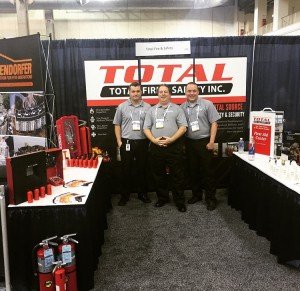 The Total Fire & Safety team is on the scene today at the 2015 Chicagoland Cooperator’s Condo, HOA, Co-Op and Apt. Expo at Navy Pier in Chicago. Pictured here at the TFS booth are (from left to right) Jeff Buff, (Customer Service Representative), Randy Donka (Outside Sales Representative), and Marc Spinder, (Outside Sales Representative). The Total Fire & Safety team is on the scene today at the 2015 Chicagoland Cooperator’s Condo, HOA, Co-Op and Apt. Expo at Navy Pier in Chicago. Pictured here at the TFS booth are (from left to right) Jeff Buff, (Customer Service Representative), Randy Donka (Outside Sales Representative), and Marc Spinder, (Outside Sales Representative).
The show brings together thousands of board and association members, property managers, homeowners and apartment building owners to meet, attend educational seminars and get their questions answered.

For Total Fire & Safety, this is a chance to showcase our various fire safety and first aid solutions. If you’re in the downtown area, join us today at Navy Pier! Free admission and lots of other freebies inside!
If we don’t see you there, contact us any time with your questions regarding fire safety. We’re here to help.
Category: Fire News, Fire Safety, Total Fire and Safety, Trends, Uncategorized Tags: chicago, chicagoland cooperator's condo, fire safety, fire safety solution, first aid, navy pier, news, TFS, today, Total Fire & Safety, Total Fire and Safety | Comments Off on Total Fire & Safety at Navy Pier!
-
October 21, 2015 by Total Fire and Safety
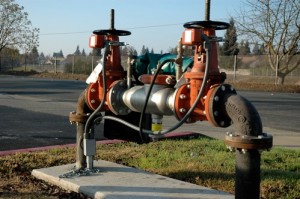 Backflow prevention systems are a must for any commercial building with large sinks, photo developing equipment, dishwashers or other machines where contaminated water is prone to backflow. Backflow prevention, sometimes known as a cross-connection control device, keeps contaminated or polluted water separate from drinking water. It is important for fire prevention systems because any water used in fighting a fire or commercial fire sprinkler systems should be potable. Backflow prevention systems are a must for any commercial building with large sinks, photo developing equipment, dishwashers or other machines where contaminated water is prone to backflow. Backflow prevention, sometimes known as a cross-connection control device, keeps contaminated or polluted water separate from drinking water. It is important for fire prevention systems because any water used in fighting a fire or commercial fire sprinkler systems should be potable.
Like any water safety system, there are also building codes that require installation of backflow prevention devices and there are specific types of backflow prevention devices that are required by code. The backflow prevention system is necessary when water is kept at high pressures to enable water flow. If the pressure fails due to an emergency (such as a broken pipe), undesirable solids, liquids, or gases may be sucked into the clean water supply.
Backflow prevention devices use an air gap, or an assembly of valves or pressure vacuums to regulate cross-connection of drinking and contaminated water systems. When drinking water and contaminated water systems meet in certain intersections of piping, the clean water must move into the contaminated water, not the other way around. If the system fails, contaminated water can backflow into clean water as the contaminated water moves to an area of lower pressure. Just as the suction of a straw directs liquid to its proper destination, so the prevention backflow system is needed to prevent cross contamination.
Since backflow prevention is an emergency system, inspection is required on a regular basis. Without regular inspection and installation, a faulty system could endanger the lives of people who drink water connected to the systems. In the past, a lack of working backflow prevention has even led to contamination of entire towns!
The installation, inspection and certification of backflow prevention systems should always be handled by professionals who are experienced with such systems. If you have questions regarding your backflow prevention system, contact Total Fire & Safety for more information.
Category: Fire Safety, Sprinkler Systems, Total Fire and Safety Tags: backflow, backflow prevention, building code, cross connection control, cross-connection, plumbing, plumbing device, plumbing questions, safety, valves | Comments Off on Why Your Backflow Prevention Device is Important
-
August 27, 2015 by Total Fire and Safety
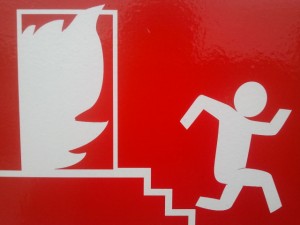 The NFPA has done a myriad of studies on the causes of fires in different types of businesses and public. For example, fires in office spaces are much more likely on weekdays when people are in the building, and also less likely (about 31 percent less likely) between the hours of 7 p.m. and 7 a.m. However, the fires that do happen between those hours tend to do more damage. In industrial and manufacturing facilities, about two thirds of all fires occurred specifically in manufacturing facilities as opposed to industrial, utility, defense, agriculture, or mining properties. It is always important that fire safety equipment such as commercial sprinklers and commercial fire extinguishers are up to date and properly installed so that fire risks are minimized. Here are some lists of the top five causes of fires in certain types of businesses, with number one being the most prevalent. The NFPA has done a myriad of studies on the causes of fires in different types of businesses and public. For example, fires in office spaces are much more likely on weekdays when people are in the building, and also less likely (about 31 percent less likely) between the hours of 7 p.m. and 7 a.m. However, the fires that do happen between those hours tend to do more damage. In industrial and manufacturing facilities, about two thirds of all fires occurred specifically in manufacturing facilities as opposed to industrial, utility, defense, agriculture, or mining properties. It is always important that fire safety equipment such as commercial sprinklers and commercial fire extinguishers are up to date and properly installed so that fire risks are minimized. Here are some lists of the top five causes of fires in certain types of businesses, with number one being the most prevalent.
TOP FIVE CAUSE OF FIRES IN…
OFFICE PROPERTIES
1. Cooking Equipment
2. Electrical distribution and lighting equipment
3. Heating equipment
4. Intentional
5. Smoking materials
MANUFACTURING PROPERTIES
1.Flammable or combustible liquids or gases, piping, or filter
2.Dust, fiber, link, including sawdust or excelsior
3.Electrical wire or cable insulation
4.Unclassified item first ignited
5.Structural member of framing
MERCANTILE PROPERTIES
1.Cooking equipment
2.Electrical distribution and lighting equipment
3.Heating equipment
4.Intentional
5.Smoking materials
RELIGIOUS AND FUNERAL PROPERTIES
1.Cooking equipment
2.Heating equipment
3.Intentional
4.Electrical distribution or lighting equipment
5.Candles or lightning
Knowing what kind of fire risks your business is most likely to face is an important step in preventing them. Make sure to contact a fire safety professional at Total Fire & Safety to stay in compliance and protect your business from possible fires.
Category: Total Fire and Safety, Trends, Uncategorized Tags: fire causes, fire danger, fire in business, fire in commercial buildings, fire safety, fire statistics, risk of fire, statistics | Comments Off on Leading Causes of Fires in Commercial Properties
|

|
|
|
|
|
|

 Facebook
Facebook
 Instagram
Instagram
 LinkedIn
LinkedIn












